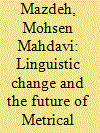| Srl | Item |
| 1 |
ID:
180016


|
|
|
|
|
| Summary/Abstract |
The metrical requirements of Persian poetry are highly restrictive. Traditionally, the rigidity of the metrical system was compensated for by a high degree of flexibility in the poetic language in terms of lexicon, phonology, and morpho-syntax. Using statistical data from different periods of Persian poetry, this paper argues that the degree of flexibility of the language used in metrical Persian poetry has been in constant decrease, moving towards what may potentially be a language crisis for metrical Persian poetry. This study traces the linguistic and meta-linguistic origins of the initial flexibility of the poetic language and its subsequent change, suggesting that some of the recent trends in Persian poetry may be viewed in part as reactions to this potential crisis.
|
|
|
|
|
|
|
|
|
|
|
|
|
|
|
|
| 2 |
ID:
192970


|
|
|
|
|
| Summary/Abstract |
The study of language and script change among the Turkic communities of the Soviet Union often focuses on the switch from Arabic to Latin scripts. Less attention is paid to adaptations of the Arabic script to Turkic vernaculars, and to attempts aimed at convincing the literate masses of their usefulness. In the current paper, I aim to do just that. By making use of Turkic-language periodicals from Crimea, Azerbaijan and Uzbekistan, I throw light on the era before Latin. I explore writers’, editors’ and other intellectuals’ efforts to vernacularize written languages and enforce national boundaries along Soviet lines through changes to the dominant script. More than this, I investigate these actors’ use of magazines to convince their readers of new vernacular, language- and territory-based national identities. In doing so, I demonstrate that periodicals became implements of national consciousness creation targeted at the Turkic citizens of the early Soviet Union.
|
|
|
|
|
|
|
|
|
|
|
|
|
|
|
|